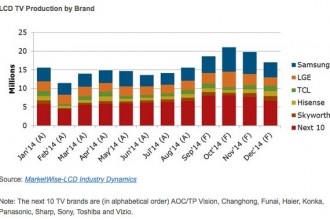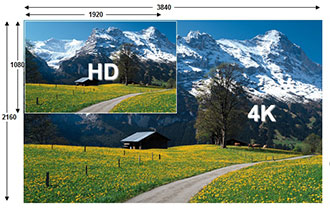Faster 4Kx2K, Slower AMOLED TV?
It seems that AMOLED TVs might take longer to be commercialized than most realized. The challenges of producing AMOLED TV panels include the TFT backplane and the organic materials evaporation and encapsulation processes. Recently in Berlin, the OLED leaders, Samsung Display and LG Display, demonstrated their 55” Full HD OLED TVs, not only at the IFA exhibition but also in retail stores. Both companies introduced new technologies and concepts into their OLED TVs, such as LG’s four-color pixel white OLED technology, and Samsung’s “multi-view” technology, as analyzed in the Weekly TV Supply Chain Executive Briefing report. The competition between Samsung and LG stimulates each to make more progress in OLED TV. However, the question of when mass production will start still went unanswered. One might recall that the original mass production schedule was said to be Q2’12, and then in time for the London Olympic Games, and now by the end of 2012.
At the same time, there are two big arguments before OLED TV reaches the shelves. First, who will buy a US$10,000 OLED TV in the current environment, when a 60” LCD TV with slim type LED backlight will be sold at less than US$1,000? Secondly, what will be the differentiating factors and the value proposition for an OLED TV when LCD TV also offers slim form factor and excellent image quality?
In addition to AMOLED, panel makers are emphasizing 4Kx2K LCD TV panels, and we will likely see 4Kx2K LCD TVs coming to market faster than OLED TVs. Panel makers like Samsung Display, LG Display, Sharp, AUO, and Chimei Innolux are all gearing up to produce 4Kx2K panels, in sizes ranging from 50” to 84”, while LCD TV brands like Samsung, LGE, Sony, Sharp, Toshiba, Hisense, Haier, Changhong, TCL and Konka have announced 4Kx2K LCD TV products.
OLED vs. 4Kx2K TV Announcements

Source: Weekly TV Supply Chain Executive Briefing report
There might be some reasons for the 4Kx2K to go faster from panel makers’ perspective
The success of smartphones, tablet PCs and high-end PCs has proved that end users recognize the value of high resolution and are willing to pay for it.
Although there are still many challenges, 4Kx2K content and broadcasting are moving forward. Already Hollywood has published several 4Kx2K movie titles such as “Money Ball” and “The Girl with the Dragon Tattoo.” 4K cameras and camcorders are widely available. Meanwhile, 4K up-scaling technology is improving.
As panel makers want to move consumers to larger sizes (50” and above), full HD resolution might not be good enough picture quality. Ultra high definition (UD) might be an important feature for LCD TV makers to promote larger sizes.
Compared to AMOLED TV panels, 4Kx2K panel manufacturing is relatively easy because smaller pixels are the only change. Oxide TFT technology is recognized as the best approach for high resolution due to faster electron mobility, but some panel makers like AUO and Chimei Innolux have implemented conventional a-Si process for 4Kx2K panels.
If the productivity and yield rate are well-controlled, 4Kx2K will enable panel makers to increase profitability. A 50” 4Kx2K panel is priced at $800, compared to $400 for a full HD panel with slim type LED backlight, while an 84” 4K panel will be priced over $5,000.
In the Quarterly Global TV Shipment and Forecast Report, DisplaySearch is forecasting that 4Kx2K will account for 2 percent of LCD TVs in 2017, and 22 percent of the 50”+ market.
This column was reprinted with permission from DisplaySearch and originally appeared here.





